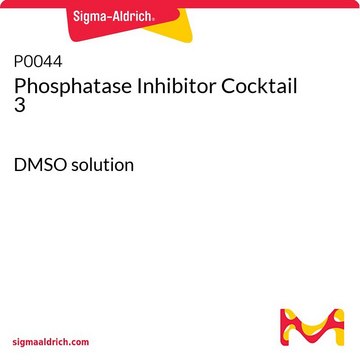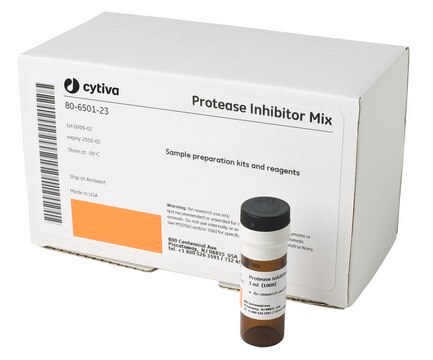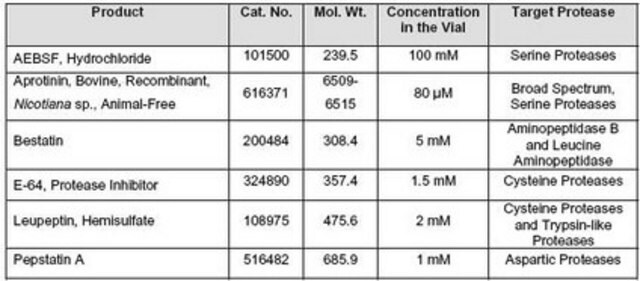P1860
Protease Inhibitor Cocktail
DMSO solution, for the inhibition of serine, cysteine, aspartic proteases and aminopeptidases, for use in tissue culture media, DMSO solution
Sinonimo/i:
Protease Inhibitor Solution, protease inhibitor
Autenticatiper visualizzare i prezzi riservati alla tua organizzazione & contrattuali
About This Item
Prodotti consigliati
Nome del prodotto
Cocktail di inibitori delle proteasi, for use in tissue culture media, DMSO solution
Livello qualitativo
Stato
DMSO solution
Solubilità
water: soluble
Condizioni di spedizione
dry ice
Temperatura di conservazione
−20°C
Cerchi prodotti simili? Visita Guida al confronto tra prodotti
Descrizione generale
Protease Inhibitor Cocktail demonstrated non-toxicity towards the following cell lines after 48 hours exposure:
A431, CHO, COS, HepG2, and HeLa adherent cell lines
Jurkat and HL-60 cell lines grown in suspension
A431, CHO, COS, HepG2, and HeLa adherent cell lines
Jurkat and HL-60 cell lines grown in suspension
The Protease Inhibitor Cocktail is a mixture of protease inhibitors designed to prevent proteolytic degradation of secreted proteins in tissue culture media.
Specificità
Inhibits serine, cysteine, aspartic proteases, and aminopeptidases
Applicazioni
Protease Inhibitor Cocktail has been used:
- as a supplement in supernatants and lysates for ex vivo infection experiments using human precision-cut lung slices (PCLS)
- to inhibit proteolysis by trypsin to prove that proteolysis is responsible for restoration of catalysis of corona-inhibited nanozymes
- in trypsin solution for trypsin-inhibited studies
- as a component in radioimmunoprecipitation assay (RIPA) buffer to lyse leukocytes for western blot
This product is specifically optimized for use in tissue culture media and can be added after 48 hours of exposure to fresh medium to ensure the continued inhibition of proteases.
Azioni biochim/fisiol
Protease inhibitor cocktail is designed for use in tissue culture media. It is recommended as an additive to tissue culture media to safeguard against the degradation of secreted proteins originating from the cultured tissue.
Caratteristiche e vantaggi
- Broad specificity
- Non-toxic: After 48 hours exposure, the product is non-toxic to adherent cell lines A431, CHO, COS, HepG2 and HeLa; and to Jurkat and HL-60 cell lines grown in suspension.
- Contains no metal chelators: Ensures compatibility with downstream applications
- Convenient packaging: 1 mL in glass bottle
- Easy to use: Use at a dilution of 1:200 or more in tissue culture media to prevent proteolytic degradation of secreted proteins.
Componenti
Aprotinin
Bestatin
E-64
Leupeptin
Pepstatin A
Bestatin
E-64
Leupeptin
Pepstatin A
Avvertenza
After 48 hours exposure, the product is non-toxic to adherent cell lines A431, CHO, COS, HepG2 and HeLa; and to Jurkat and HL-60 cell lines grown in suspension.
Quantità
Use at a dilution of 1:200 or more in tissue culture media to prevent proteolytic degradation of secreted proteins.
Stato fisico
Solution in DMSO (D 2650, Hybri-Max).
Altre note
For R&D use only. Not for drug, household, or other uses. Please consult the Safety Data Sheet for information regarding hazards and safe handling practices.
Prodotti correlati
N° Catalogo
Descrizione
Determinazione del prezzo
Codice della classe di stoccaggio
10 - Combustible liquids
Classe di pericolosità dell'acqua (WGK)
WGK 1
Punto d’infiammabilità (°F)
188.6 °F
Punto d’infiammabilità (°C)
87 °C
Scegli una delle versioni più recenti:
Possiedi già questo prodotto?
I documenti relativi ai prodotti acquistati recentemente sono disponibili nell’Archivio dei documenti.
I clienti hanno visto anche
Raymond L Warters et al.
Radiation research, 172(1), 82-95 (2009-07-08)
Although skin is usually exposed during human exposures to ionizing radiation, there have been no thorough examinations of the transcriptional response of skin fibroblasts and keratinocytes to radiation. The transcriptional response of quiescent primary fibroblasts and keratinocytes exposed to from
Takuma Shiratori et al.
Journal of immunology (Baltimore, Md. : 1950), 200(1), 218-228 (2017-11-17)
As osteoclasts have the central roles in normal bone remodeling, it is ideal to regulate only the osteoclasts performing pathological bone destruction without affecting normal osteoclasts. Based on a hypothesis that pathological osteoclasts form under the pathological microenvironment of the
Matthew Townsend et al.
The Journal of physiology, 572(Pt 2), 477-492 (2006-02-14)
The accumulation of amyloid beta-protein (Abeta) in brain regions serving memory and cognition is a central pathogenic feature of Alzheimer's disease (AD). We have shown that small soluble oligomers of human Abeta that are naturally secreted by cultured cells inhibit
Vanessa Neuhaus et al.
PloS one, 8(8), e71728-e71728 (2013-08-24)
Annual outbreaks of influenza infections, caused by new influenza virus subtypes and high incidences of zoonosis, make seasonal influenza one of the most unpredictable and serious health threats worldwide. Currently available vaccines, though the main prevention strategy, can neither efficiently
Rachel Kaminsky et al.
Developmental cell, 17(5), 724-735 (2009-11-20)
Sumoylation is a reversible posttranslational modification that plays roles in many processes, including transcriptional regulation, cell division, chromosome integrity, and DNA damage response. Using a proteomics approach, we identified approximately 250 candidate targets of sumoylation in C. elegans. One such
Il team dei nostri ricercatori vanta grande esperienza in tutte le aree della ricerca quali Life Science, scienza dei materiali, sintesi chimica, cromatografia, discipline analitiche, ecc..
Contatta l'Assistenza Tecnica.













